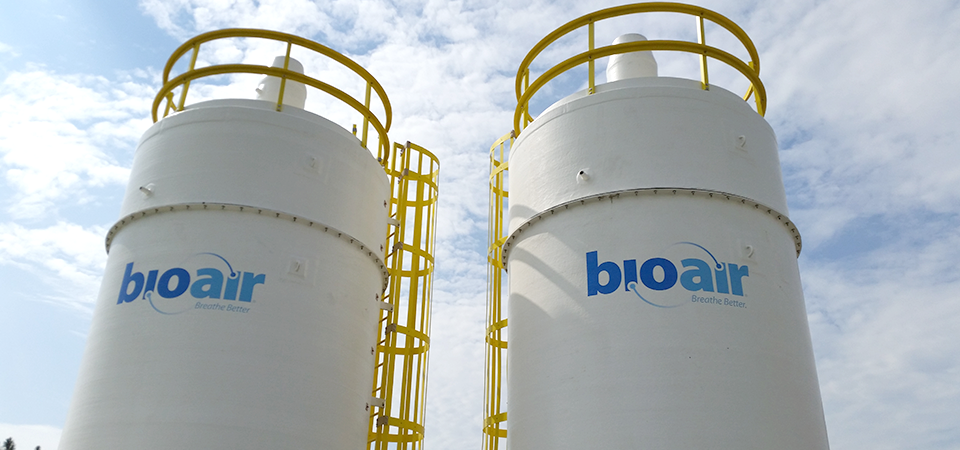Pungent mercaptans odors are the source of numerous nuisance complaints and originate in a wide variety of industrial processing facilities and wastewater treatment sites.

Mercaptans, also known as thiols, are gaseous compounds formed when organic matter breaks down under anaerobic conditions. These molecules are similar in structure to phenols and alcohols, but they contain a sulfur atom in place of oxygen.
With detection thresholds as low as a few parts per trillion (ppt), pungent mercaptans odors are the source of nuisance complaints near pharmaceutical production plants, food and beverage facilities, oil and gas processing sites and industrial and municipal wastewater treatment plants.
As populations spread toward outlying industrial and municipal facilities, owners increasingly realize that treatment of odors from organic reduced sulfur compounds, and mercaptans in particular, is necessary.
Formation of mercaptans
The sources of mercaptans odors are many and varied. Examples of common sources include:
- Anaerobic breakdown of waste materials in municipal sewage treatment facilities. Methyl mercaptan (CH3SH) is a common offending compound.
- Stripping of naturally occurring sulfur compounds from crude oil or natural gas, such as methyl mercaptan, ethyl mercaptan (CH3CH2SH) and propyl mercaptan (C3H8S).
- As a byproduct of many biochemical and pharmaceutical processes.
Mercaptans are much like hydrogen sulfide (H2S), another common compound released from the sources listed above; treatment of both types of compounds is similar. We discuss mercaptans treatment in the next section. (To read more about treating hydrogen sulfide odors, read this article.)
What specifically determines which odorous compounds form during decomposition remains a topic of scientific inquiry. It was previously believed that the formative and degradative pathways of mercaptans and hydrogen sulfide compounds were related. But according to recent studies, these pathways might be different even if the circumstances of decomposition are not.
Challenges in mercaptans odor control
While mercaptans are closely related to hydrogen sulfide and can be effectively controlled in similar ways, there are some specific challenges that facility managers and owners should understand. First, mercaptans’ detection thresholds are much lower. It takes a much smaller concentration of a mercaptan compound to spur a complaint compared to hydrogen sulfide.
Second, mercaptans are not as water-soluble as hydrogen sulfide. Water solubility is a key characteristic of compounds that determines how effectively they become available to bacteria for breakdown in biological treatment.
Third, mercaptan molecules are more complex than hydrogen sulfide molecules. There are more steps involved in the biological breakdown of mercaptans, so treating them can take longer and may result in the formation of intermediary compounds that need treatment.
Mercaptans odors can be controlled via biological, physical and chemical means. Each is discussed below.
Biological mercaptans odor control
Biological solutions rely on bacteria (such as heterotrophic bacteria) and fungi (phanerochaete chrysosporium) to break down mercaptan molecules. Differing biological methods are used:
Traditional biofilters– These are pits filled with organic media like wood chips, mulch or grass clippings where microorganisms naturally occur. As impacted air is forced up through the media, mercaptan molecules are consumed by the organisms. While traditional biofilters can be effective, they work slowly, cannot handle high odor loads, take up lots of space and must have their media periodically replaced.
Bioscrubbers– Impacted air is collected and piped through an enclosed vessel. Inside the vessel, either natural or synthetic porous media harbors microorganisms that consume mercaptan molecules. As the impacted air travels through the media, it encounters recirculated water that draws the molecules into the water phase. Then, the compounds are consumed and the byproducts drained away. Clean air is released. Bioscrubbers can handle higher odor loadings in smaller spaces compared to biofilters, but recirculating water homogenizes the environment in the vessel, eliminating the healthy biodiversity required for optimum treatment. Controlling bioscrubbers to optimize mercaptans treatment is difficult.
Biotrickling filters– Similar to bioscrubbers, biotrickling filters also contain media designed to house microorganisms that consume unwanted odorous compounds. But these units rely only on fresh water passing through the filter only once. This configuration supports an environment where a wider range of diverse microorganisms can thrive. A wider range of microorganisms can treat odorous compounds more effectively.
When appropriate, BioAir Solutions prefers to use its EcoFilter® biotrickling filter to eliminate mercaptans odors. EcoFilter units feature engineered synthetic media that enhance the environment in which microorganisms thrive and provide a more uniform and efficient odor treatment. BioAir’s research shows that its biotrickling filters routinely exceed 99% treatment efficiency.
Physical mercaptans odor control
Adsorptive filters physically trap unwanted compounds while clean air is released into the environment. The adsorptive media used in such a system varies based on the compound targeted for treatment, but activated carbon is the most common.
Our EcoCarb® adsorptive filter harnesses the power of adsorptive media to effectively trap mercaptan molecules. The benefit of choosing physical mercaptans odor control is that these systems are well-established with a proven track record of success. A possible drawback is the recurring cost of periodic replacement of carbon.
Chemical mercaptans odor control
Chemical odor control systems rely on a mixture of water and chemicals to move odorous compounds into the water phase, where a chemical reaction occurs. That reaction results in byproducts that are drained away; meanwhile, clean air is released from the vessel.
Chemical odor control systems are also well-established and have been successful in a wide variety of municipal and industrial applications (learn more about our chemical treatment system, Qimi®, here). However, depending on the nature of an odor problem, the chemicals used in the treatment can be dangerous to handle. They’re also expensive, contributing to chemical units’ comparatively high operating cost.
Providing mercaptans odor control solutions
BioAir Solutions is proud of its reputation as a solution provider to air and emissions problems. That means we won’t steer you toward choosing the odor control system we want to sell. Rather, we’ll recommend the system that will best address your unique challenge.
In fact, many of the solutions we develop are combined systems—such was the case when we built a custom treatment system for the largest brewery in Australia. Each system is carefully designed based on our in-depth on-site survey of your facility and our analysis of odor samples we collect there. To learn more about our approach to understanding and eliminating industrial and municipal odors, read about our BioAir Complete® program.
If mercaptan odors from your site are causing persistent nuisance complaints, we’d be happy to come out for a site audit. Schedule one here.
